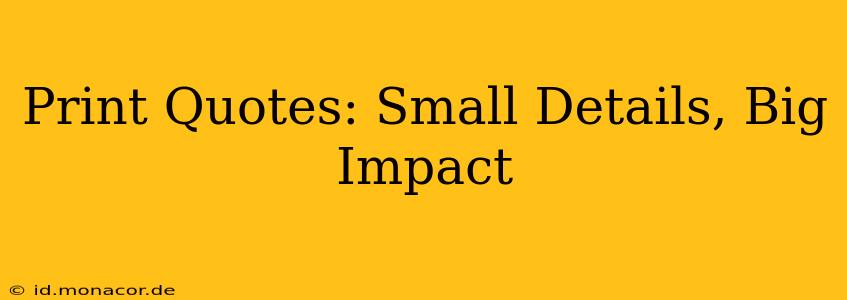Print quotes—those seemingly insignificant snippets of text accompanying images or placed strategically within a document—hold a surprising power to elevate the overall aesthetic and effectiveness of your printed materials. Often overlooked, these small details can significantly impact how your message is received and remembered. From enhancing brand identity to guiding the reader's eye, print quotes are a powerful design tool. This article explores the subtle art of utilizing print quotes effectively, offering insights into their impact and practical tips for maximizing their potential.
What Makes Print Quotes Effective?
Effective print quotes go beyond simple text placement. They involve careful consideration of typography, placement, and context. A well-chosen quote can:
- Enhance brand identity: Quotes reflecting your brand's values and mission create a stronger connection with your audience.
- Add visual interest: A strategically placed quote can break up large blocks of text and improve the visual flow of your design.
- Reinforce key messages: Quotes can highlight important points, making them more memorable and impactful.
- Build credibility: Using quotes from experts or respected figures adds authority and trust to your message.
- Evoke emotion: A carefully selected quote can stir feelings and create a more engaging reading experience.
How to Choose the Right Quote for Your Print Material
Selecting the perfect quote is crucial. It needs to resonate with your overall message and target audience. Consider these factors:
- Relevance: Does the quote directly support your message or brand?
- Brevity: Shorter quotes are generally more effective. Aim for conciseness and impact.
- Style: Ensure the quote's tone and style align with your brand's voice.
- Attribution: Always attribute the quote to its source, unless it's a commonly known phrase.
- Copyright: Make sure you have the right to use the quote, especially if it's from a copyrighted work.
What Font and Size Should I Use for Print Quotes?
Typography plays a vital role in the effectiveness of print quotes. Consider these points:
- Font Choice: Select a font that complements your overall design and is easy to read. A contrasting font can make the quote stand out.
- Font Size: The font size should be larger or smaller than the surrounding text to create visual hierarchy.
- Emphasis: Use bolding, italics, or a different color to draw attention to the quote.
How Can I Position Print Quotes Effectively?
The placement of a print quote greatly influences its impact. Consider these strategies:
- Visual Hierarchy: Use size and placement to guide the reader's eye.
- Proximity: Place the quote near relevant images or text.
- Whitespace: Use whitespace effectively to give the quote breathing room.
- Background: Consider a contrasting background color or texture to make the quote pop.
What are Some Creative Ways to Use Print Quotes?
Beyond simple text boxes, experiment with creative approaches:
- Callouts: Use callouts to pull quotes from within a larger text block.
- Image Overlays: Overlay quotes on images for a visually striking effect.
- Custom Shapes: Use unique shapes or borders to highlight your quotes.
What if I Don't Have a Great Quote to Use?
If you're struggling to find the perfect quote, consider these alternatives:
- Create your own tagline: Craft a short, memorable phrase that captures the essence of your message.
- Use a relevant statistic: A compelling statistic can be as effective as a quote.
- Focus on strong visuals: If a quote isn't necessary, let the imagery do the talking.
By carefully considering these aspects, you can transform simple print quotes into powerful design elements that elevate your printed materials, leaving a lasting impression on your audience. The impact of these small details should not be underestimated; they contribute significantly to the overall success of your communication.

